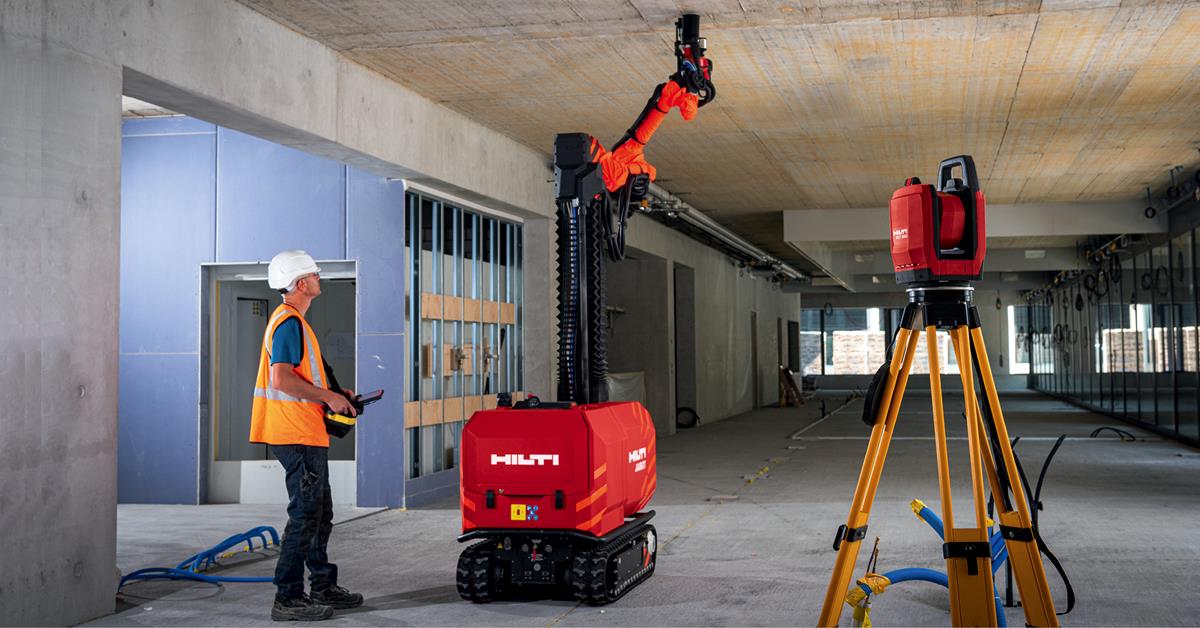Drilling robot creates a better work environment
In Malmö, regional health authority Region Skåne is in the process of modernising and expanding the university hospital campus with a new building containing modern wards, operating theatres, clinics and intensive care units. Assemblin has been contracted to perform electrical, HVAC and control installations for the project. To assist in the work, installers have a new colleague in the form of the Hilti Jaibot drilling robot.
Drilling holes in ceilings is associated with a number of risks: the body is subjected to vibrations from tools, the work is dusty and working above shoulder height is wearing on the joints, not to mention the risk of falls and the noisy work environment.
To address these problems, power tool manufacturer Hilti has developed a semi-automated drilling robot for working on ceilings. This innovative technology is now being used by Assemblin, including for installing ventilation in one area of the new hospital building on the Skåne University Hospital campus in Malmö, which is being built by Skanska.
“We marked the boreholes on a CAD model, which was then exported to the robot. This is part of our work with building information modelling (BIM), which also facilitates the quantifying of suspension and mounting materials. This has allowed us to achieve a more precise design and optimisation of the suspension system. The robot was then controlled by an operator from Hilti,” explains Fredrik Engdahl, business development manager at Assemblin Ventilation.
Compared to an installer drilling the holes, the challenge of this procedure is that all information regarding factors such as beams and other installations in the ceiling must be included in the drawing sent to Hilti. If any information is missing, there is a risk that the holes will be wrongly positioned.
Thus far, the success rate in terms of holes being in the right place has been 80%.
“However, we expect to be able to improve that figure to approximately 90% going forward,” Engdahl emphasises.
Improving the work environment
Assemblin Ventilation has been working on installations in the new hospital building since September 2019 and, if everything goes according to plan, the north wing should be ready for occupation by 2024 and the south wing by 2025. Employing a robot to perform certain tasks has required a slightly different mindset.
“Certain conditions are required for the robot to function; for example, the floor must be clear so it can get about on its caterpillar tracks. And the same applies to the ceiling, which must be clean and free of hanging electrical installations,” says Engdahl.
“So, it demands good coordination between contractors before the robot can go in and get the job done; we can’t work in the same way as we used to,” adds Assemblin Ventilation project manager Anders Lindvall.
Still, what the robot demands in preparation is made up for by the improved work environment and ergonomic aspects. Installers can concentrate on their principal task of installing and avoid hazardous or fatiguing steps. Assemblin has also enlisted the help of two logistics companies in the project, to transport and carry installation materials to further relieve employees of burdensome tasks.
Future capacity increases
Anders Lindvall and Fredrik Engdahl see great opportunities to increase the use of the robot in future.
“In this project, we are running the robot from 07:00 until 16:00 – i.e., traditional working hours in the building industry – but in the future it might very well operate around the clock, which would of course greatly increase capacity!”
